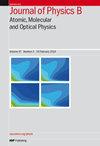共振 X 射线差频发生器
IF 1.5
4区 物理与天体物理
Q3 OPTICS
Journal of Physics B: Atomic, Molecular and Optical Physics
Pub Date : 2023-12-19
DOI:10.1088/1361-6455/ad0f39
引用次数: 0
摘要
共振增强 X 射线差频发生(re-XDFG)是一种二阶非线性效应,它涉及用光子能量为 Ω1 和 Ω2 的双色 X 射线脉冲照射分子。能量差Ω1-Ω2 的调整与分子中原子的 X 射线吸收边缘相匹配。我们利用密度泛函理论计算,对气相中不同分子的再 XDFG 效应进行了数值研究,并验证了目标跃迁的非中心对称特性。考虑到不同的双色输入脉冲几何形状,对具有永久偶极子的两级分子系统进行了重新XDFG描述评估。这种创新的非线性 X 射线方法提供了一种利用非共振 X 射线测量高密度介质中碳、氮或氧等轻元素 K 边 NEXAFS 光谱的方法。它还可用于研究线性光谱学无法获得的化学材料动力学。这些发现使原子尺度结构与化学特异性相结合,并利用硬 X 射线脉冲选择性地局部获取 X 射线激发。本文章由计算机程序翻译,如有差异,请以英文原文为准。
Resonant x-ray difference frequency generation
Resonantly enhanced x-ray difference-frequency generation (re-XDFG) is a second-order nonlinear effect that involves illuminating a molecule with two-color x-ray pulses with photon energies Ω1 and Ω2. The energy difference
Ω 1 − Ω 2 is tuned to match an x-ray absorption edge of an atom in the molecule. We have numerically studied the re-XDFG effect considering different individual molecules in the gas phase using density functional theory calculations and have verified the non-centrosymmetric character of the target transitions. Two-level molecular systems with permanent dipoles are evaluated for the description of re-XDFG taking into account different two-color input pulse geometries. This innovative nonlinear x-ray methodology offers a means to measure the K-edge NEXAFS spectrum of light elements, such as carbon, nitrogen, or oxygen, in dense media using non-resonant x-rays. It can also be used to investigate chemical material dynamics that are inaccessible by linear spectroscopy. These findings enable the combination of atomic-scale structure with chemical specificity and the selective and local access to x-ray excitations using hard x-ray pulses.
求助全文
通过发布文献求助,成功后即可免费获取论文全文。
去求助
来源期刊
CiteScore
3.60
自引率
6.20%
发文量
182
审稿时长
2.8 months
期刊介绍:
Published twice-monthly (24 issues per year), Journal of Physics B: Atomic, Molecular and Optical Physics covers the study of atoms, ions, molecules and clusters, and their structure and interactions with particles, photons or fields. The journal also publishes articles dealing with those aspects of spectroscopy, quantum optics and non-linear optics, laser physics, astrophysics, plasma physics, chemical physics, optical cooling and trapping and other investigations where the objects of study are the elementary atomic, ionic or molecular properties of processes.

 求助内容:
求助内容: 应助结果提醒方式:
应助结果提醒方式:


